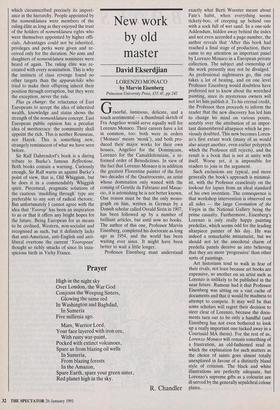New work by old master
David Ekserdjian
LORENZO MONACO by Marvin Eisenberg
Princeton University Press, £55.45, pp.242
Graceful, luminous, delicate, and a touch sentimental — a thumbnail sketch of Fra Angelico would serve equally well for Lorenzo Monaco. Their careers have a lot in common, too: both were in orders (`Monaco' means `monk'), and both pro- duced their major works for their own houses, Angelico for the Dominicans, Lorenzo for the Camaldolensians, a re- formed order of Benedictines. In view of the fact that Lorenzo Monaco is in addition the greatest Florentine painter of the first two decades of the Quattrocento, an artist whose domination only waned with the coming of Gentile da Fabriano and Masac- cio, it is astonishing he is not better known. One reason must be that the only mono- graph on him, written in German by a Danish scholar called Osvald Siren in 1907, has been followed up by a number of brilliant articles, but until now no books. The author of this one, Professor Marvin Eisenberg, completed his doctorate as long ago as 1954, and the world has been waiting ever since. It might have been better to wait a little longer.
Professor Eisenberg must understand exactly what Berti Wooster meant about Fate's habit, when everything seems tickety-boo, of creeping up behind one with a sock full of wet sand. In a one-side Addendum, hidden away behind the index and not even accorded a page-number, the author reveals that `After this book had reached a final stage of production, there came to my attention an important panel by Lorenzo Monaco in a European private collection. The subject and ownership of the work presently may not be divulged.' As professional nightmares go, this one takes a lot of beating, and on one level Professor Eisenberg would doubtless have preferred not to know about the wretched painting, since its mysterious owners will not let him publish it. To his eternal credit, the Professor then proceeds to inform the reader that the new discovery has led him to change his mind on various points, notably over the attribution of an impor- tant dismembered altarpiece which he pre- viously doubted. This now becomes Loren- zo's first extant work (many of us would also accept another, even earlier polyptych which the Professor still rejects), and the result is a book that is not at unity with itself. Worse yet, it is impossible for readers to join in the argument.
Such exclusions are typical, and more generally the book's approach is minimal- ist, with the Professor ceaselessly on the lookout for lapses from an ideal standard of his own invention. The consequence is that workshop intervention is observed on all sides — the large Coronation of the Virgin in the National Gallery being the prime casualty. Furthermore, Eisenberg's Lorenzo is only really happy painting predellas, which seems odd for the leading altarpiece painter of his day. He was indeed a remarkable miniaturist, but we should not let the anecdotal charm of predella panels deceive us into believing that they are more 'progressive' than other sorts of paintings.
Art historians tend to walk in fear of their rivals, not least because art books are expensive, so another on an artist such as Lorenzo is unlikely to be published in the near future. Rumour had it that Professor Eisenberg was sitting on a vast cache of documents and that it would be madness to attempt to compete. It may well be that some scholars will regret their decision to steer clear of Lorenzo, because the docu- ments turn out to be only a handful (and Eisenberg has not even bothered to look up a really important one tucked away in a Courtauld MA thesis). For the rest of us, Lorenzo Monaco will remain something of a frustration, an old-fashioned read in which the explanation for such matters as the choice of saints goes almost totally unexplored in favour of a distinctly bland style of criticism. The black and white illustrations are perfectly adequate, but Lorenzo's supreme gifts as a colourist are ill served by the generally sepulchral colour plates.


























































 Previous page
Previous page